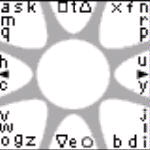Friday 23 December 2005

|
Pic of the day: Don't expect this image to make sense at first glance. QuikwritingI am writing this on my pocket PC using Quikwriting, yet another input method for the pocket PC. Every bit as weird as Dasher but less gamelike, it consists of a kind of small wheel or flower. In the middle is a hub or center where you start. Each of the 8 surrounding "petals" contains a number of letters or controls like space, backspace or shift. The most common letters only require a small dash by the stylus out from the center and into the relevant petal. Rare letters may require you to sweep through 2 or 3 petals, but it can still be done in one single sweep. In fact, every letter or digit is a sweep, only their shape varies. Some are short and sharp, others larger and rounder. Since the petals have some size, you may vary the size of the sweep, as long as you stay inside the petals. ***Now you may reasonably ask why you should learn yet another alphabet. After all, Pocket PCs and Palms have on-screen keyboards and handwriting recognition built-in, and more are available for download. You already know how to use those; after all, you have been typing for years and writing for almost as long as you can remember. Why invent the wheel again? In this case, it could be because the original wheel wasn't all that round to begin with. The alphabet as we know it was not designed, it evolved. Pictograms that just happened to have the right sound, became simplified into letters. Depending on the original picture, they could still be needlessly complex. Even cursive handwriting, which was developed in more recent times, varies wildly: Some letters are simple, such as l and o. Others are quite a bit more complex, like k. There is no obvious reason why, just the luck of the draw. In contrast, Quikwriting is designed to minimize finger movement while writing English. The interesting part comes when writing words rather than letters. Because each letter is a single sweep returning to the center, the stylus is immediately ready to begin another. Admittedly some of these flow more readily than others, but it is never necessary to lift the stylus or interrupt the flow of writing until you wish to. (You can lift the stylus while still in the petal to cancel a letter -- useful in the beginning when you still make mistakes.) Once you have used it a little,you will likely begin to think of small words and syllables as patterns on movement. Your hand can execute these patterns without thinking, and for every day there are more of them. It is a fascinating process to watch. Perhaps it was like this when we first learned to write too, but then we were not self-aware enough to pay attention to the process. ***So is Quikwriting really useful, or is it something geeks do just because we can? To be honest, right now for me it is the geek thing. I can write faster using handwriting, tapping the on-screen keyboard or, on this machine, using the built-in micro keyboard ("thumbboard"). Don't even get me started on using a full-sized keyboard (I have one that can be connected to the Pocket PC wirelessly with Bluetooth) or even speech recognition, which is bound to be THE hot thing for handhelds once their processing power is up to it. (At least one company is working to put the actual processing on a chip.) So no, I don't think Quikwriting will ever be a household name. But it is an interesting experience. Are you geek enough to try? |
Yesterday <-- This month --> Tomorrow?